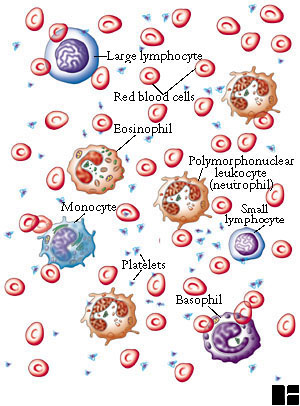HTTP://WWW.WHFREEMAN.COM/immunology/CH03/kuby03.htm
Chapter 3: Cells & Organs of the Immune System
 |
Figure 3-1.Morphology and staining characteristics of various types of blood cells. Red blood cells and platelets, which both lack nuclei, are the most numerous. Most numerous of the leukocyte populations are the neutrophils. Lymphocytes are the predominant cell type responsible for immune responses. |
The immune system is constituted by a
surprising variety of different cell types disseminated
throughout the body and collectively defining one's capacity to
mount an immune response. All blood cells and certain other cells
located throughout the body - particularly in the reticuloendothelial system (RES) - are continuously regenerated throughout life by the
process called hematopoiesis. Most hematopoietic cells are short lived, some
surviving for only a day or two, and thus hematopoiesis serves to
maintain a steady renewal of these cells on physiological demand.
Hematopoiesis is believed to be the function of a single
precursor cell called the pluripotent stem cell (SC). In addition
to being self-renewing, SCs undergo multi-lineage differentiation
driven by stage-specific cytokine and cell-cell interactions (Figure 3-2).
In general, hematopoietic cells are highly
mobile, moving with the flow of blood in the cardiovascular
system or with the flow of lymph in the lymphatic system. Many of
these cells also cross-migrate between these two circulatory
systems, and many migrate directly into the tissues, particularly
under the influence of inflammatory cytokines with
chemoattractive properties. High concentrations of hematopoietic
cells, particularly lymphocytes, are also localized in the primary lymphoid organs, i.e., thymus and bone marrow, and secondary lymphoid
organs, e.g., spleen, lymph nodes, etc.
(Figure
3-16).
Obviously, the task of identifying different
hematopoietic cells is a special challenge considering the sheer
diversity of these cells. Most of the basic cell types can be
distinguished on a gross morphological level using various cytochemical
staining techniques. However, some of
the basic cell types are comprised of heterogeneous mixtures of
functionally distinct subpopulations that are morphologically
indistinguishable. In this case, immunologists resort to
monoclonal antibodies directed against specific cell-surface
molecules called CD antigens. CD antigens are
differentially expressed on leukocytes and distinct cell
subpopulations can be identified and even isolated according to
their patterns of CD antigen expression.
[TOP]
[Chapter 3: A. Blood Cell Morphology & Staining]
[Chapter 3: B. Cluster of Differentiation (CD) Antigens]
[Chapter Resources]
[Immunology Home Page]
W. H. Freeman & Co. and Sumanas, Inc.
Immunology, January, 1997
Last Updated: June 24, 1997
